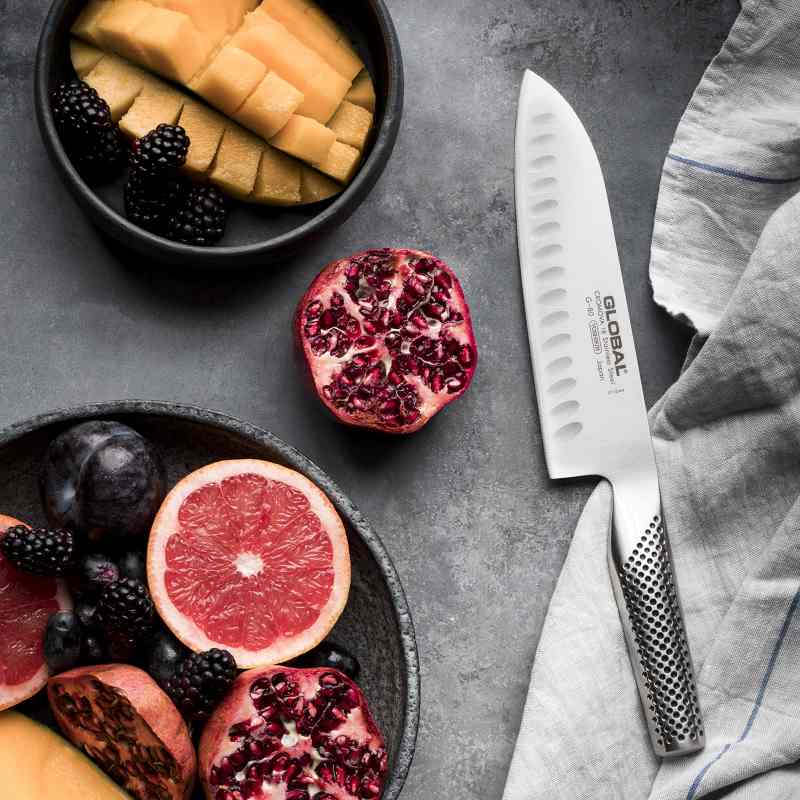 In the world of culinary arts, the importance of using the right knife for the job cannot be overstated.
In the world of culinary arts, the importance of using the right knife for the job cannot be overstated.
Each knife has its own unique purpose, and selecting the right knife can make all the difference in the outcome of a dish. One knife that has become increasingly popular in recent years is the Santoku knife.
What is a Santoku Knife?
Origin and history of Santoku knives
Santoku knives originated in Japan and have been used by Japanese chefs for centuries. The name "Santoku" translates to "three virtues" or "three uses," referring to its ability to slice, dice, and mince with ease. While Santoku knives were originally used in Japan, they have gained popularity worldwide and are now a common kitchen tool in many households.
Anatomy of a Santoku knife
Santoku knives typically have a shorter and wider blade than a traditional Chef's knife, with a length ranging from 5 to 7 inches. The blade is made from high-quality stainless steel, which allows for easy sharpening and maintenance. The handle is typically made from a durable material such as wood or plastic and is designed to provide a comfortable grip.
Key features of Santoku knives
Santoku knives also have a thinner blade than traditional Chef's knives, making them lighter and easier to handle. Additionally, Santoku knives often have a Granton edge, which features small indentations along the blade that reduce friction and prevent food from sticking to the blade.
Santoku Knife vs Chef's Knife
Pros and cons of using Santoku knives
There are several pros to using a Santoku knife. Due to its lighter weight and unique shape, Santoku knives are easier to handle than Chef's knives, making them a good choice for those with smaller hands or weaker grip strength. However, Santoku knives may not be suitable for tasks that require a longer blade or heavier weight, such as breaking down large cuts of meat or chopping through bone.
When to use a Santoku knife over a Chef's knife
Santoku knives are a versatile tool that can be used for a wide range of tasks in the kitchen. They are particularly useful for tasks that require precision and finesse, such as chopping herbs or slicing vegetables. If you have a smaller cutting board or limited counter space, a Santoku knife may also be a better choice than a larger Chef's knife. However, if you frequently prepare larger cuts of meat or need to chop through bone, a Chef's knife may be a better option. Ultimately, the choice between a Santoku knife and a Chef's knife will depend on your individual needs and preferences in the kitchen.
How to Choose a Santoku Knife
Factors to consider when choosing a Santoku knife
When choosing a Santoku knife, there are several factors to consider. Firstly, consider the blade material, as this will affect the knife's durability and sharpness. Look for a knife with a high-quality stainless steel blade. You should also consider the handle material and grip, as this will affect the knife's comfort and ease of use. Additionally, think about the size of the blade, as this will affect the knife's versatility and performance.
Popular brands of Santoku knives
There are many popular brands of Santoku knives, each with their own unique features and benefits. Some popular brands include Shun, Wusthof, and Global. These brands are known for producing high-quality knives that are both durable and sharp.
Recommended sizes and materials for Santoku knives
Santoku knives typically come in sizes ranging from 5 to 7 inches. While there is no one-size-fits-all solution, a 5 to 6-inch blade is a good choice for most home cooks. As for materials, look for a high-quality stainless steel blade and a comfortable handle made from a durable material such as wood or plastic. Additionally, consider the weight of the knife, as a lighter knife may be easier to handle for some users.
Ultimately, when choosing a Santoku knife, it is important to consider your individual needs and preferences in the kitchen. Consider factors such as blade material, handle material, size, and weight to find the perfect Santoku knife for your cooking style.
How to Use a Santoku Knife
Proper grip and hand positioning
When using a Santoku knife, it is important to have the proper grip and hand positioning to ensure safety and efficiency. Hold the handle firmly with your dominant hand, with your thumb and index finger wrapping around the handle near the blade. Your other three fingers should wrap around the handle towards the end. Use your other hand to hold the food in place on the cutting board, keeping your fingers curled under and away from the blade.
Basic cutting techniques with a Santoku knife
The Santoku knife is a versatile tool that can be used for a variety of basic cutting techniques, such as chopping, slicing, and dicing. To chop, use a rocking motion with the blade to quickly and efficiently chop ingredients. To slice, use a gentle sawing motion, pulling the blade towards you as you cut through the ingredient. To dice, start by slicing the ingredient into even slices, then chop those slices into smaller pieces.
Advanced cutting techniques with a Santoku knife
The Santoku knife can also be used for more advanced cutting techniques, such as julienning and chiffonading. To julienne, slice the ingredient into thin, matchstick-like strips. To chiffonade, stack several leaves or pieces of an ingredient on top of each other, roll them tightly, then slice into thin ribbons.
It is important to note that, like any knife, a Santoku knife should be used with care and caution. Always use a sharp blade and pay attention to where your fingers are in relation to the blade. With practice and patience, you can become a skilled and efficient user of a Santoku knife.
Caring for Your Santoku Knife
Proper storage of Santoku knives
Proper storage of a Santoku knife is important for both safety and longevity. Never store your knife loose in a drawer or counter where it can be damaged or cause harm. Instead, use a knife block, magnetic strip, or knife sheath to keep the blade protected and in good condition. When storing in a block or sheath, make sure the blade is dry to prevent corrosion.
Sharpening and honing a Santoku knife
To maintain the sharpness and performance of your Santoku knife, it is important to regularly sharpen and hone the blade. Sharpening should be done using a sharpening stone or electric sharpener. Honing, on the other hand, should be done using a honing steel to straighten the blade's edge.
Maintenance tips for keeping a Santoku knife in top condition
In addition to proper storage and sharpening, there are other maintenance tips to keep your Santoku knife in top condition. First, always hand wash the blade and handle with mild soap and water, then dry thoroughly. Avoid soaking the knife or putting it in the dishwasher, as this can cause damage to the blade and handle. Additionally, never use the knife to cut through bones or frozen foods, as this can damage the blade. Finally, store the knife in a dry place to prevent rust and corrosion.
By following these care and maintenance tips, you can ensure that your Santoku knife stays in top condition and continues to perform at its best for years to come.
Using the right knife for the job is crucial for efficiency, precision, and safety in the kitchen. Santoku knives are a versatile and valuable tool that every home cook should consider adding to their collection. Bulmers Gifts have a range of Santoku knives and can assist you in making the right choice for your cooking needs.

























